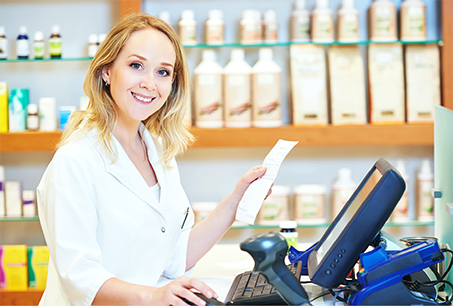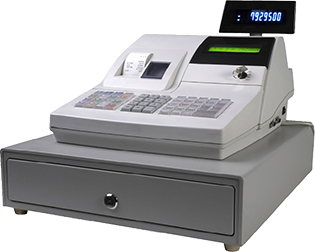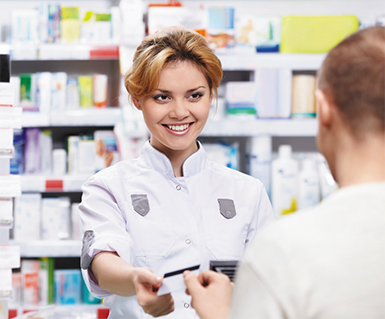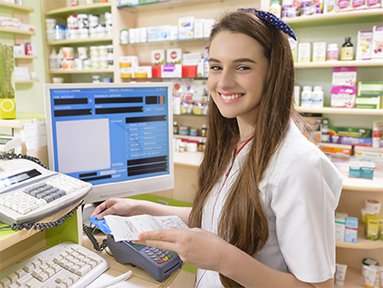9.4 Cash Register Management
As part of working in a retail pharmacy, you are responsible for collecting payments from customers. The price of each prescription, medical supply, OTC drug, supplement, and retail item is either scanned with a bar coder to pull the price into the point-of-sale (POS) cash register (an automated cash register system), or it is hand entered into a less automated one. Cash register procedures differ with each pharmacy and its technology.
There are separate buttons on the cash register for “Rx” (nontaxable prescription items) and other retail merchandise (taxable items). There are also separate buttons for cash, credit cards, and checks. The retail items, including OTC drug products and dietary supplements, will usually have bar codes for the cash register scanner for easy pricing. If an item is on sale, the sale price should be reflected on the bar code. Independent pharmacies often have sale price stickers attached to items that are then hand entered into the cash register.

Pharmacy personnel must be able to handle the responsibilities of filling prescriptions while also working on the retail end of running the cash register for customer purchases.
When a prescription code is scanned, the computer system may automatically prompt the technician to offer the patient counseling by the pharmacist. (Also, the pharmacist often makes notes on the medication bag to indicate that the patient needs counseling.) Scanning particular OTC items—such as pseudoephedrine products and Schedule V cough syrups—may activate a prompt for you to ask for additional information from the patient, such as proof of age, identification, and a signature to comply with federal and state laws.
The register has a drawer at the bottom with a removable tray that has separate compartments for various denominations of bills and coins. Checks, credit card receipts, and bills larger than $20 are generally kept in a separate compartment or underneath the money tray in the drawer. All credit card receipts (and coupons) are also placed under the change tray or in a separate, secure location for reconciliation at the end of the day (which will be explained in the end of this section).
Taxable Versus Nontaxable
FDA-approved prescription drugs for humans (not animals) and certain medically necessary supplies are federally exempt from states adding any sales tax, so these are nontaxable items. Tax-exempt medical supplies include disposable or consumable medical items (such as glucose test strips and nutritional drinks for diabetic patients) and durable medical equipment (such as canes, walkers, crutches, orthopedic and diabetic shoes, but not hospital beds). Other nontaxable items include prescribed devices such as neck collars, ankle braces, slings, and wrist and arm braces.
 Practice Tip
Practice Tip
If a prescriber writes a prescription for a medical supply or a piece of durable medical equipment, it is generally considered a medical necessity and is not taxable.
States can choose to make many common health and first-aid items such as thermometers, adhesive bandages, medicated gum, OTC drugs, and dietary supplements taxable items. You will need to get to know your state laws since sales taxes are determined by the states. Generally, common retail merchandise items (such as magazines, cards, carbonated drinks, cosmetics, pet products, toys, gifts, snack foods, and tobacco) are all subject to taxes. Some states allow baby formulas, dietary supplements, herbs, foods, and bottled water to be exempt from taxes, while others tax them.
The states also determine the rate of the sales tax to be added—generally a small percentage of the purchase price. Each pharmacy’s cash register is programmed to apply the state’s tax laws, so that is why pressing the correct code button for the type of purchase is key—then the register will automatically do the tax math for you.

A cash register often requires replacement of the paper roll and/or ink toner to print a readable receipt for each patient transaction, so technicians need to get to know this key skill.
Payment Options
Customers often pay for their purchases using various cards (credit cards, debit cards, flex cards, and gift cards), cash, or checks. Each payment option has a unique processing method; these payment methods should be demonstrated in the pharmacy’s training program. Regardless of the form of payment, the pharmacy technician should always present the customer a payment receipt, or proof-of-purchase printout.
Learning the ins and outs of your pharmacy’s particular cash register and receipt system is important—even how to change the paper printout ribbon or the ink cartridge (see Table 9.3). Think of how frustrating it is for the customer if you don’t know how to fix or refill these when they run out.
Table 9.3 Changing Paper and Ink
|
If the paper receipt is streaking red, it is time to replace the paper roll. Though each cash register will differ, with different release levers, the process generally follows in this order: |
|
|
If the receipt printout is faint, it is time to replace the ink roller. This small, plastic roller is located underneath the receipt paper exit. Remove the cover, slip out the roller, clip the replacement back in (cash register model–specific), and replace the cover. Check YouTube for a step-by-step video on the model of cash register in your pharmacy for more specific instructions. Newer cash registers often employ thermal printers, which typically require that you change the paper roll only. |
Online Card Transactions
The various kinds of payment cards need to be verified with a card-swiping monitor or chip reader for online transaction approval (pharmacy gift cards need in-house approvals of card amounts). Though sometimes you will do the swiping, the most common technology has the customer swipe or insert any type of card and follow the prompts. The processing company will either approve or decline the amount needed. If the amount submitted is declined, you will have to ask for an alternative card or form of payment.
Credit and debit cards often allow customers the option to request cash back after the claim is processed. Cash-back options may be limited ($20 or less) or not available per store policy. Some chain pharmacies offer customers the express pay option, where the customer puts their credit card on file to be processed automatically at the time of prescription filling.
Any payment done with a credit card either must be paid off by the customer at the end of the month or it accrues interest as a finance charge. Depending on pharmacy policy, patients may or may not need to sign for a credit card expense of less than $50. In most independent pharmacies, patients will sign for every credit card transaction.
Debit Cards A debit card is also a form of online cash payment, but unlike a credit card loan, a debit card instantly deducts the purchase cost from the customer’s bank account. A debit card purchase requires the customer to enter a PIN for account verification. Generally, if the PIN is used, these cards do not require a signature because the money is immediately transferred from the bank account. However, as with credit cards, the amount submitted is sometimes declined, and then you will have to ask for some other form of payment. A debit card can be processed as a credit card if it is inconvenient for the customer to enter a PIN, such as when picking up prescriptions at a drive-through pharmacy.
EMV Chips To decrease fraudulent use, most credit and debit cards have moved to EMV chip credit cards, or cards with an embedded computer chip. (The chip is named after the three major developers: Europay, Mastercard, and Visa). Instead of swiping the credit card, the card is inserted into a chip reader available at the cash register. Each time the card is used, a one-time-only code will be utilized to process the transaction.

If a credit card, debit card, or check is refused for insufficient funds, a technician must politely return the payment and ask in a friendly manner for a new form of payment.
Mass retailers and chain pharmacies have adopted chip readers. While it is not required to have a chip reader, without one, liability for fraud falls back onto the retailer rather than the credit card issuer. The customer must type in a confidential PIN or sign the transaction on screen or paper. This new technology has been nicknamed “chip and pin” or “chip and signature.” This technology will eliminate duplicate or fraudulent cards, but it does not yet address added security for online sales. Pharmacies will have to handle both forms of credit cards for some time as the transition is in progress.
Flex Cards A flex card is a medical debit card for out-of-pocket “qualified medical expenses,” according to the IRS. Such expenses include all prescriptions, insulins, and OTC items that are written as prescriptions. The flex credit card minimizes the need for submission of receipts, prevents delays in reimbursement, and offers tax advantages. It has an allotted amount of money on the card account, as in a debit card bank account, which is “rechargeable” by adding more money.
Gift Cards Unlike credit, debit, and flex cards, gift card charges are made against an account balance linked to the card’s bar code. The bar code on the gift card is scanned or manually entered. With product or store coupons, as well as drug rebate forms, the technician must carefully review the requirements and expiration date before scanning.
Cash
Cash transactions are fairly straightforward. At the start of each business day, each cash register begins with a set number of bills and coins. Large bills, such as $50 and $100 bills, are usually placed under the change drawer to minimize mix-ups. Always, always check the kind of bill offered to you by the customer before putting it into the change drawer so that you don’t assume that a $20 bill is a $10 dollar bill or vice versa. Scam artists can hand you a lower bill denomination and say that they gave you a higher one. They can also give you counterfeit money, so do a quick check as bills are put in your hands. To become proficient in identifying counterfeit bills, go to https://PharmPractice7e.Paradigmeducation.com/Counterfeit.
Most cash registers automatically display the change due for each transaction. Knowing how to count change is a key skill for excellent customer service and pharmacy accounting. You can easily practice at home, as there is an art to doing it confidently (see Table 9.4).
Table 9.4 Counting Change
|
Counting change out to a customer is essential for good service. The cash register’s screen will tell you the amount to return if you have properly scanned and/or punched in all the numbers of the product price and money offered you. But you cannot just plop the change into the customer’s hand. You need to count the cash as you hand it back to show that it is the correct amount. Say that a woman purchases a bottle of Tylenol and a bottle of vitamin C for the total purchase price of $10.73. She offers you a $50 bill. There are two ways to count her change: |
|
Counting out the amount listed on the register
|
Counting change starting from the register total is the easiest for the technician, but it is not for the customer. Customers often do not know off the top of their heads how much change they should receive. They generally feel most comfortable having the change counted back to them starting at the purchase price and ending at the cash they gave you. |
|
Counting from the purchase price
|
Personal Checks
Some customers elect to pay for their pharmacy purchases with a personal check, though this is becoming less common and some businesses no longer accept checks. Procedures differ, depending on the pharmacy. Larger pharmacies usually have a check reader connected to the cash register. The signed check is fed into the reader and the bank account is immediately accessed. In some cases, the check reader prints the entire check, ready for customer signature. If the account shows insufficient funds, a prompt alerts you not to accept the check and to seek an alternate source of payment. If the check transaction is successfully processed, you can return the check to the customer along with a receipt.
For pharmacies without a check reader, if the patient is not recognized as a regular customer, you may need to ask for identification, such as a driver’s license, and to transfer that information to the check. The amount of the check and the signature should always be verified. Checks written for a large amount (commonly greater than $100) may require approval of the store manager, since it is possible for the pharmacy to receive a check with insufficient funds to cover the bill. Most pharmacies have a policy of charging a high fee to rebill bad checks. In some cases, the pharmacy keeps a list of customers who are not allowed to pay with checks.
Personal Charge Accounts and Delayed Billing
Some independent pharmacies allow their most frequent customers to run a charge account and have the pharmacy bill them at the end of the month. This is a convenience for the customer but adds to operating expenses of the pharmacy, so it needs to be done with prudence, as decided by the owners.
Price Verification, Voided Sales, and Refunds
Cashiering includes some other functions that technicians need to know how to handle. Customers often ask to verify the price of store items or, in some cases, to modify them. You can scan the bar code on the item for price checking. If the advertised price is not accurately reflected, you will have to manually enter it into the register. If the pharmacy is out of stock on a buy one, get one free item, you may be allowed to adjust the price by 50%, depending on store policy.
Occasionally, completed sales need to be voided because a mistake has been made or the customer changes their mind. For instance, the drugs are not covered by insurance, the copays are too high, or the merchandise is not available at the price the customer thought. Following store policies, you will likely void the transaction on the cash register, initial the receipt, and document the reason for the void before storing it in the register. If a patient is due a refund from a prior purchase, you may need to obtain administrative approval from either the pharmacist or the store manager before proceeding with the refund.

It is important for a technician to log off of the register when it is not in use.
At the end of the business day (or a shift), a pharmacy manager or a designated technician has the responsibility to reconcile, or match, the cash, credit card receipts, personal checks, coupons, rebates, voided sales, and patient charges (if allowed) with the printout from the cash register.
To do this, the bills, coins, and checks in the cash register drawer must be counted, and the amount of cash in the register when the day started must be subtracted. The amount left must equal the exact amount of cash-check transactions that occurred as tallied by the cash register. The credit and debit transaction receipts will also be counted to check against the register totals of credit-debit transactions. Voided transactions and discounts must also be subtracted.
Then these totals must be added to those of other registers to find the full amount of business for the day. The complete total will be checked against the total of the purchase prices of the prescriptions filled and merchandise sold according to the bar code scanners, minus the insurance reimbursements expected. It is complicated, but automation does a great deal of the work. The bar code scanning technology works in concert with the POS cash register. A POS cash register has the advantage of automatically reordering inventory at the end of each day.
In larger pharmacies with multiple technicians, pharmacists, and POS cash registers, it is not uncommon for each technician to have a sign-on and password code to enter when starting the shift on a certain register, to assist in tracking transactions and reconciling the receipts at the end of the day or shift. A technician is accountable for all customer receipts at their register during the shift. It is common to be off a few cents or dollars once in a while, but frequent or large discrepancies are brought to the attention of the pharmacist. Major cash discrepancies during a technician’s shift, especially if there is a pattern of such discrepancies, will require explanation and should be discussed privately. Surveillance cameras are available in many pharmacies to protect the pharmacy from money loss or drug diversion by staff or customers.